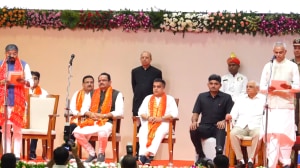Fashion forward
Bye bye to the Bengal school, hello to the gown. And no, the recession is not coming in the way of the fashion week glutfest

Bye bye to the Bengal school, hello to the gown. And no, the recession is not coming in the way of the fashion week glutfest
In 2008, as the organisers of the New York and London fashion weeks debated the relevance of the catwalk show and considered the cheaper alternative of webcasts, India hosted three fashion weeks within a month. Next year, there will be a fourth, dedicated to men’s garments. Recession, anyone? But 2008 has been an interesting year for Indian fashion. The country’s first mall dedicated to international luxury brands opened in Delhi, the war within the Fashion Design Council of India threw up a new faction of designers and some fashion stars made a dramatic impact with bold new ideas, challenging the concept of Indian formalwear. And what of 2009? Here’s what to watch out for:
PROM QUEENS
Before petite designer sisters Gauri and Nainika Karan burst on the fashion scene with their ultra-girly feminine gowns and dresses designed to make you look and feel like Cinderella, no Indian actress was spotted at film premieres in dresses made by an Indian label. The Gauri-Nainika contribution to Indian fashion is significant because they created a market for formal Western wear that nobody thought existed. The saree is now in danger of being ousted by the gown as younger Bollywood actresses’ choice for formal wear, on occasions other than weddings. Last year, Deepika Padukone, Priyanka Chopra, Katrina Kaif and Aishwariya Rai were photographed in Gauri-Nainika dresses—full-bodied gowns in starched silks with organza ruffles. Critics can rant about their designs being John Galliano rip-offs, but the sisters are a step ahead of their peers; their collection for 2009 at Wills India Fashion Week was one of the few that followed the season’s toned-down colour palette of maroons, beige, deep reds and black. Next year, watch Gauri-Nainika consolidate their position in formal Western wear and enter the couture space.
KITSCH CANNED
The Bengal school of fashion that combines different textures and antique textiles, a vibrant colour palette, embroidery and bling, has ruled bridal fashion and sarees since Kolkata boy Sabyasachi Mukherjee first invented this look in 2002. The kitschy patchwork, fusion of styles and the overt celebration of Indian tradition have taken many designers like Manish Arora and Anamika Khanna into the big league. But since fashion, like art, mirrors reality, the sombre mood in the country will hasten the end of lavish, over-the-top garments. Expect the use of a starker palette, with severe lines and subtle styling. Though fashion choices tend to be whimsical, when times get tough, even fashionistas veer towards designs that are more real and long-lasting.
LUXURY’S HERE TO STAY
The signages for Louis Vuitton and Dior can be spotted a kilometre away from Delhi’s Emporio Mall. Recession or not, India’s first mall dedicated to international luxury is opening new stores every day, targeted at the country’s new luxury consumers, that number among the highest in the world. It’s easy to read the desolate atmosphere inside the mall as a sign that nobody’s going there, but Emporio isn’t a hangout zone; it’s targeted at the customer who is beginning to appreciate luxury. By end 2009, this mall will play host to almost every global luxury brand. With a new spa and the start of the exclusive Emporio club membership, this will be India’s most fashionable address to shop at.





- 01
- 02
- 03
- 04
- 05


























